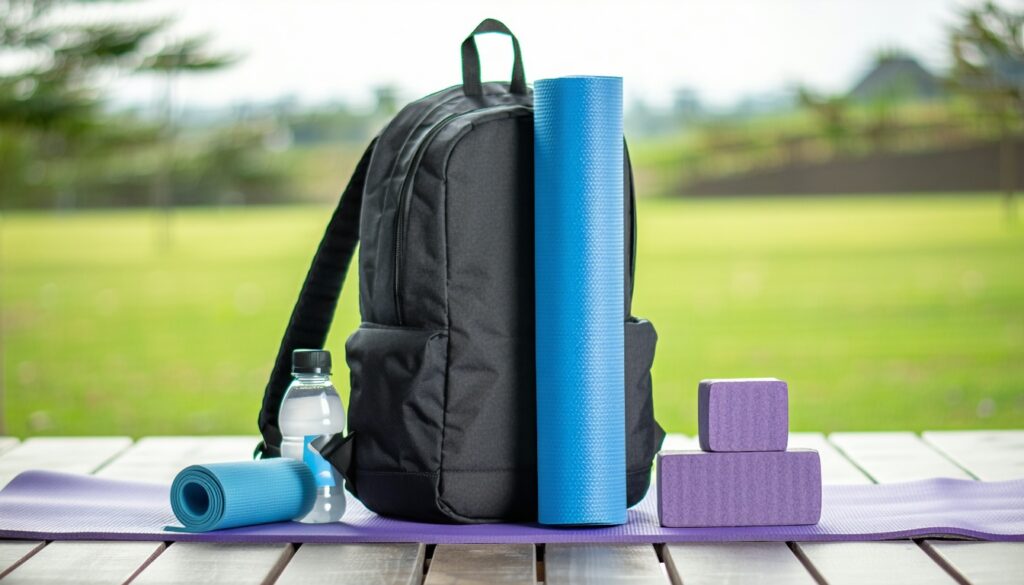Easy Steps to Convert a Regular Backpack into a Yoga Mat Holder

DIY Yoga Mat Holders
Creating a practical and stylish way to carry a yoga mat can be both fun and rewarding. Here are two popular methods for transforming a regular backpack into a yoga mat holder: making a yoga mat sling and customizing a yoga mat bag.
Making a Yoga Mat Sling
To convert a regular backpack into a yoga mat holder, one effective method is to create a yoga sling. This process involves using specific materials to craft a simple yet functional sling that can securely hold a yoga mat.
Materials Needed:
- Durable fabric (like cotton or nylon)
- Scissors
- Sewing machine or needle and thread
- Measuring tape
- Clips or rings for attachment
Steps:
- Measure the length of your yoga mat and cut the fabric accordingly.
- Fold the fabric and sew the edges to create a sturdy strap.
- Attach clips or rings to the ends of the sling for easy attachment to the backpack.
- Adjust the sling to fit your mat securely.
This DIY sling allows for easy transport of the yoga mat while keeping hands free for other essentials.
Customizing a Yoga Mat Bag
Another option is to customize a yoga mat bag that fits your specific needs. This method allows for personalization based on the dimensions of the yoga mat, making it suitable for both yoga and exercise mats. A comprehensive tutorial is available at 5 out of 4 Patterns.
Customization Ideas:
- Add a cell phone pocket inside the bag for convenience.
- Adjust the length of the bag to ensure it can close securely around the mat.
- Choose fabric colors and patterns that reflect personal style.
Many individuals have successfully used this tutorial to create their own yoga mat bags, expressing satisfaction with the clear directions and the final results.
By following these DIY methods, health-conscious individuals can create functional and stylish carriers for their yoga mats, making it easier to transport gear to classes, studios, or while traveling. For more tips on selecting the right yoga backpack, check out our article on how to choose the right yoga backpack for your practice.
Constructing a Yoga Mat Bag
Creating a yoga mat bag can be a fun and rewarding project. This section will guide you through adding a drawstring and strap, as well as modifying the bag design to suit your needs.
Adding Drawstring and Strap
To enhance the functionality of the yoga mat bag, incorporating a drawstring and strap is essential. The drawstring allows for easy access and secure closure, while the strap makes it convenient to carry.
-
Construct the Casing: Start by creating a casing for the drawstring at the top of the bag. This involves folding over the fabric and sewing it down, leaving enough space for the drawstring to pass through.
-
Add Grommets or Buttonholes: For added durability, consider adding grommets or buttonholes where the drawstring will exit the casing. This prevents wear and tear on the fabric.
-
Thread the Drawstring: Once the casing is ready, thread the drawstring through it. You can use a safety pin to help guide it through the casing.
-
Attach the Strap: Finally, sew a strap onto the bag. This can be a simple fabric strap or a more padded option for comfort. Ensure it is securely attached to support the weight of the mat and any additional items.
The bag includes a drawstring and a strap, adding to its functionality as a yoga mat holder.
Modifying the Bag Design
Customization is key when constructing a yoga mat bag. Modifying the design can make it more practical for individual needs.
-
Adjust the Size: Measure your yoga mat and adjust the dimensions of the bag accordingly. This ensures a snug fit, preventing the mat from slipping out.
-
Add Pockets: Consider adding pockets for essentials like a phone, keys, or a water bottle. A reader modified the yoga mat bag pattern by sewing a cell phone pocket inside.
-
Lengthen the Bag: If necessary, make the bag a little longer to ensure it can close securely around the mat. This modification can help accommodate thicker mats or additional gear.
-
Personalize with Fabric: Choose fabrics that reflect personal style. Bright colors or patterns can make the bag more visually appealing.
The tutorial provides guidance on how to make a yoga mat bag that is customizable based on the measurements of the individual’s mat, making it suitable for both yoga and exercise mats.
By following these steps, individuals can create a functional and stylish yoga mat bag that meets their specific needs. For more tips on choosing the right yoga backpack, check out our article on how to choose the right yoga backpack for your practice.
Wall-Mounted Yoga Mat Holder
Creating a wall-mounted yoga mat holder is a practical solution for health-conscious individuals looking to keep their yoga gear organized and accessible. This section will cover the design and dimensions of the holder, as well as customization and assembly tips.
Design and Dimensions
The wall-mounted yoga mat holder is designed to accommodate multiple yoga mats and accessories. It typically holds up to three yoga mats, two yoga blocks, and a bolster. Additionally, it features pegs for resistance bands or straps, making it a versatile storage solution.
| Component | Dimensions |
|---|---|
| Overall Width | 24″ |
| Overall Depth | 9 1/4″ |
| Overall Height | 32 3/4″ |
| Top Shelf (for Bolster) | Sized to fit a standard bolster |
| Bottom Shelf (for Blocks) | Designed to hold 2 yoga blocks |
The top shelf can also be used for other exercise gear or decorative items, allowing for a personalized touch in your yoga space. For more details on how to create your own holder, check out how to sew your own custom yoga bag with mat compartment.
Customization and Assembly
Customization options for the yoga mat holder are plentiful. It can be tailored to hold however many mats you have, ensuring it meets your specific needs. The holder is typically constructed using poplar boards, which provide durability and a clean aesthetic. A wood wax finish gives it a matte, unfinished look that blends well with various decor styles.
Assembly is straightforward, especially with the use of a Kreg pocket hole jig, which simplifies the process of joining the boards together. The holder is securely mounted to the wall using 2 1/2″ wood screws through the top back support board, ensuring stability and safety.
For those interested in maintaining their yoga gear, it’s essential to know how to clean and care for your yoga backpack. Visit our article on how to clean and maintain your yoga backpack for tips on keeping your equipment in top shape.
By following these guidelines, individuals can create a functional and stylish wall-mounted yoga mat holder that enhances their practice and keeps their space organized.
Choosing a Yoga Mat Backpack
Selecting the right yoga mat backpack is essential for health-conscious individuals who regularly practice yoga. A well-chosen backpack not only enhances convenience but also ensures that all necessary gear is easily accessible.
Size and Capacity Considerations
When choosing a yoga mat backpack, it is important to consider the size and capacity that will best suit individual needs. The backpack should comfortably fit the yoga mat along with any additional items needed for practice.
| Item | Recommended Size |
|---|---|
| Standard Yoga Mat | 24″ x 68″ |
| Backpack Capacity | 20L – 30L |
A backpack with a capacity of 20 to 30 liters is generally sufficient for carrying a standard yoga mat and other essentials. For more information on selecting the right size, check out our guide on how to choose the right yoga backpack for your practice.
Features for Comfort and Functionality
Comfort and functionality are key features to look for in a yoga mat backpack. Adjustable straps allow for a customized fit, ensuring maximum comfort and support. They help distribute weight evenly across the shoulders and back, reducing strain and discomfort.
Extra compartments are also beneficial for organizing belongings and keeping them easily accessible. These can include separate sections for a water bottle, a pocket for a phone and keys, or designated spaces for yoga accessories.
Water-resistant material is another important feature. It ensures that the mat stays dry and protected, even in wet conditions, and helps prevent moisture from damaging belongings. High-quality polyester or nylon with a water-resistant coating is recommended.
A dedicated yoga mat holder within the backpack allows for convenient and secure carrying of the mat without the need for an additional strap or bag. This feature helps keep the mat clean and protected, preventing it from slipping or falling out.
By considering size, capacity, and essential features, individuals can find the perfect yoga mat backpack that meets their needs for both functionality and style. For more insights on different types of yoga mat carriers, explore our section on yoga mat backpack vs tote vs strap: pros and cons.
Types of Yoga Mat Carriers
When it comes to transporting yoga mats, there are several types of carriers available, each catering to different needs and preferences. Understanding these options can help health-conscious individuals choose the best solution for their yoga practice.
Strap Carriers
Strap carriers are the simplest and most lightweight option for carrying yoga mats. They are perfect for those who prefer a minimalist approach and don’t need extra storage. Typically made from durable materials, strap carriers allow users to easily sling their mats over their shoulders or across their bodies. This option is ideal for quick trips to the studio or outdoor yoga sessions.
| Feature | Description |
|---|---|
| Weight | Lightweight and easy to carry |
| Storage | Minimal, usually just for the mat |
| Ideal For | Quick trips and minimalist users |
For more information on the pros and cons of different carriers, check out our article on yoga mat backpack vs tote vs strap: pros and cons.
Bag Carriers
Bag carriers offer more protection and storage options compared to strap carriers. They are designed to hold not only the yoga mat but also additional items such as towels, water bottles, and personal belongings. This makes them ideal for those who carry more than just their mat to yoga sessions. Bag carriers often come with zippers, pockets, and compartments, providing a more organized way to transport yoga gear.
| Feature | Description |
|---|---|
| Weight | Heavier than strap carriers |
| Storage | Ample space for mat and accessories |
| Ideal For | Users needing extra storage and protection |
For tips on what to look for in a yoga backpack, visit our guide on what to look for in a yoga backpack || beginner’s guide.
Backpack Carriers
Backpack carriers are designed for maximum comfort and convenience. They distribute weight evenly across the shoulders, making them suitable for longer commutes or those who prefer a hands-free option. Backpack carriers provide ample space for all yoga gear, including mats, blocks, and personal items. This type of carrier is perfect for health-conscious individuals who want to maintain an active lifestyle while traveling or commuting.
| Feature | Description |
|---|---|
| Weight | Heavier but well-distributed |
| Storage | Large capacity for all yoga gear |
| Ideal For | Longer commutes and hands-free convenience |
For more insights on choosing the right yoga backpack, check out our article on how to choose the right yoga backpack for your practice.
By understanding the different types of yoga mat carriers, individuals can select the one that best fits their lifestyle and yoga practice.
Materials for Yoga Mat Carriers
Choosing the right materials for yoga mat carriers is essential for comfort, durability, and functionality. Two popular categories of materials are cotton and canvas, as well as nylon and polyester. Each has its unique benefits that cater to the needs of health-conscious individuals who practice yoga regularly.
Cotton and Canvas
Cotton and canvas are favored materials for yoga mat carriers due to their comfort, breathability, and durability. These fabrics are easy to clean, making them practical options for frequent yoga practitioners. The natural fibers allow for good airflow, which helps keep the contents fresh and reduces odors.
| Material | Benefits |
|---|---|
| Cotton | Soft, breathable, easy to clean |
| Canvas | Durable, sturdy, holds shape well |
For more information on how to choose the right yoga backpack, check out our guide on how to choose the right yoga backpack for your practice.
Nylon and Polyester
Nylon and polyester are commonly used in bag and backpack carriers for yoga mats. These synthetic materials are known for their durability and water resistance, making them ideal for outdoor use or in varying weather conditions. They are lightweight, which is a significant advantage for those who carry their yoga gear to classes or while traveling. Additionally, nylon and polyester are available in a wide range of colors and designs, catering to different preferences and styles.
| Material | Benefits |
|---|---|
| Nylon | Lightweight, durable, water-resistant |
| Polyester | Strong, quick-drying, easy to maintain |
For more insights on the pros and cons of different types of yoga mat carriers, visit our article on yoga mat backpack vs tote vs strap: pros and cons.
Selecting the right material for a yoga mat carrier can enhance the overall experience of transporting yoga gear, ensuring it remains stylish and functional.


